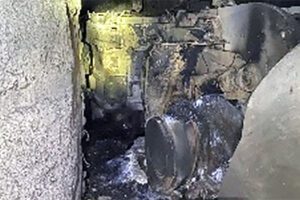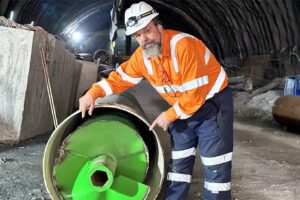OPINION: There’s an old saying “What a tangled web we weave, when we practice to deceive.” That saying might just apply to one of the world’s largest coal miners who, in cahoots with the Queensland Government, may have sought to cover up highly market sensitive information on the North Goonyella Mine Fire.
This week Peabody Energy have been accused of one of the hugest porkies in relation to the North Goonyella Mine Fire.
On Tuesday, Mathew Stevens from the Australian Financial Review (AFR) put a huge sword through the belly of Peabody Energy in his feature article ”Peabody admits that smoke really did mean fire.” Mathew highlighted that Peabody finally went to market three days after pictures had been posted publicly of black smoke billowing from the North Goonyella mine. This resulted in a massive drop in the Peabody Energy share price.
Queensland Government Cover Up
So you say, what about the Queensland Government’s role in the debacle? Well they too didn’t go public until last Friday 28/9/2018 when they (Queensland Mines Inspectorate) issued a mine safety bulletin indicating that there was a potential fire in the mine.
Of course, this begs the question, did the Queensland Government know about it at all? They only had their mines inspectors and a range of Gas Chemists sitting on site analysing the data from the mine. They couldn’t have known that mine was on fire…or could they? Were they complicit in the mammoth porky that was being perpetrated by Peabody to the market.
Time will tell if the mammoth miner had the Mines Inspectorate sign a confidentiality agreement when they asked for help. One must just sit back and think to oneself “If it looks like a rat and smells like a rat, then it probably is a rat.”
If it looks like a rat and smells like a rat, it probably is a rat
Australasian Mine Safety Journal spoke directly with a Peabody Energy representative this week on the state of the fire. Of course, the official line was “It was a changing situation, it was difficult to know actually what was going on and when.” While this sounds plausible to many, there are some underlying weaknesses in the statement. It was a cleverly crafted line of defence to obfuscate the media.
Firstly, we would hope that the Peabody Energy team and their team of advisors including Dr David Cliff (Mine Fire Expert) from the University of Queensland had some idea of what was going on underground from the outset, which may have been well before the beginning of September. North Goonyella has been prone to heating for years and, according to one former manager at the site “tinkered on the edge of a fire many, many times before.”
What our mine, nah it’s an abnormal situation
The mine had one of the most sophisticated tube bundle gas analysis systems in place and site personnel had significant experience in dealing with heatings and spontaneous combustion events. Dr Cliff had reportedly visited the mine several times before in addition to a range of Gas Experts from Simtars (Queensland Government) over the last several years.
Back many years ago Mark Blanch & Shane Stephan in their paper INERTISATION, REDUCING THE RISK AND SOLVING THE PROBLEMS: THE LESSONS OF THREE YEARS EXPERIENCE USING INERTISATION EQUIPMENT IN THE NORTHERN BOWEN BASIN presented at the Queensland Mining Industry Health & Safety Conference highlighted the nature of the problems encountered at the “Goon Show” as the mine was affectionately known.
Secondly, every mine heating and spontaneous combustion event is a changing situation…that’s just what happens during a heating. Experts, using available data, craft strategies around that data during the heating/spontaneous combustion event. They seek to isolate the heating in the early stages effectively smothering it from a supply of oxygen. It beggars belief that the site, with all their gas management systems & spontaneous combustion strategies, didn’t have an effective strategy from the early indications of this heating or spon com event.
Finally, we have been advised that workers were reportedly stood down as early as 1st September citing a potential heating as a cause for concern not to have workers underground. On the 18thSeptember when the Australian Financial Review contacted the site they were told “there had been issues but it was nothing like as serious as proposed and that a very active and capable management team was well into the process of successful mitigation of the heating and gas problems. The strategy, signed off by the Mines Inspectorate, involved, among other things, the introduction of seven pumping units that were injecting nitrogen into the coal mine in an attempt to force gas from the mine and rob it of the oxygen that might promote a fire.
Uh hum (clears throat)…ok so it’s the mines inspectorates sign off that was important to remove yourself from all responsibility of rectifying the current situation. Well that’ll be a great one to hand over to your insurer when you submit your claim for tens or hundred of millions of dollars…won’t it.
This week AMSJ put several questions to Peabody Energy regarding the event, Specifically, we asked Peabody to help the industry learn from the event so it can’t be repeated any time soon.
- What were the initial responses to the heating? Do you have a timeline of events?
- Heating and Spontaneous Combustion have apparently been an on-going issue at North Goonyella for many years, why has this situation been very different?
- You’ve engaged a team of “experts” to assist in managing this situation such as Dr David Cliff from UQ, why haven’t they been able to address the issue before it got out of hand?
- Given that Peabody has relied on a range of opinions from experts and Government throughout the course of this event, how consistent were the responses from the experts/Government in the treatment of the problem? Did they all agree with treatment options?
- If Peabody used the Tomlinson inertisation methods, why didn’t the Tomlinson work? Was the Tube Bundle Data Point adequately located in order to identify the gas concentrations from the heating?
(UPDATED STORY NOTE ON THE ABOVE QUESTION 15/10: We have been advised by a reader that the site used Floxal N2 Generators as opposed to Tomlinson Boilers in the inertisation of the fire. Initial questions were asked of Peabody on the 4/10/2018, in order to gain further information on the treatment methods of the fire. We did not assume a knowledge of the control strategy at this time, rather we sought additional information from Peabody Energy for our story.)
- What’s the probability that the GAG engine deployed by QMRS be capable of extinguishing the heating/fire? Will the output capacity of the GAG be enough to generate sufficient gas for inertisation in a mine of this size? Have you considered overseas options for mine fire control.
- Based on existing data how contained is the fire/heating to an immediate area? i.e. has it spread extensively or is isolated?
- What is Peabody doing around the existing staff? We understand that they’ve been put in a holding pattern but, many may be fearing for their future now? Is there any good news on the what will happen to staff?
- Given the serious of the situation, and the potential insurance implications for Peabody, how have insurers responded? Surely, they will be asking questions around Peabody’s actions given the rapid escalation of the incident?
- To date, what could Peabody have done better in managing this situation? Are there any lessons for industry so this situation doesn’t repeat itself?
This is the response that Peabody Energy so thoughtfully returned to us today.
“At the appropriate time, the company will initiate a formal review of the event, with the involvement of independent third parties, and intends to share learnings with the industry and other stakeholders.”
Call for Public Inquiry
Mathew Stevens (AFR) has called for the Queensland State Government to call a very public inquiry into events at North Goonyella.
Stevens highlighted that “In the weeks between first contact over North Goonyella’s gas and heating issues, we (AFR) have heard criticism of Peabody’s operational management, of its external advisors and of the mining inspectorate, which has been described as “under-resourced”, “excessively bureaucratic” and “unable to attract proper numbers of quality inspectors.”
We have no doubt that Peabody Energy will propagate the view that everyone (including AMSJ) is an expert in hindsight on the North Goonyella Mine Fire. They’ll also sow seeds of their fine upstanding social conscious and graciousness indicating that at “least they protected the safety of personnel at the site.”
Well if you or I were either a shareholder who’d lost heaps of bucks or a contractor who had been laid off at a minutes notice by Peabody Energy, you’d expect more from a company who should have known better in managing a situation that was not uncommon to this mine.
Both the market and the public deserve an answer.
If that answer comes by way of a public Government Inquiry run by the Queensland Opposition or another independent party into the circumstances surrounding the perpetrators of porkies, we’d definitely support that!
Some poor bastard manager will hang
Of course our prediction will be that Peabody Energy (as a socially responsible corporation) will hang some poor bastard mine manager/s with a noose woven from the pages of a report cleverly crafted by the Queensland Mines Inspectorate and Dr David Cliff – an independent expert.
Read more Mining Safety News














Hello, Gas issues started approx 1st of september, workers were stood down from shifts. Just saying.
Finally something on this story that makes sense. Is Peabody just playing the market here or are they just f^%&*g incompetent. Feel sorry for the manager who they’re going to crucify about this. Thats it fir his time in the industry